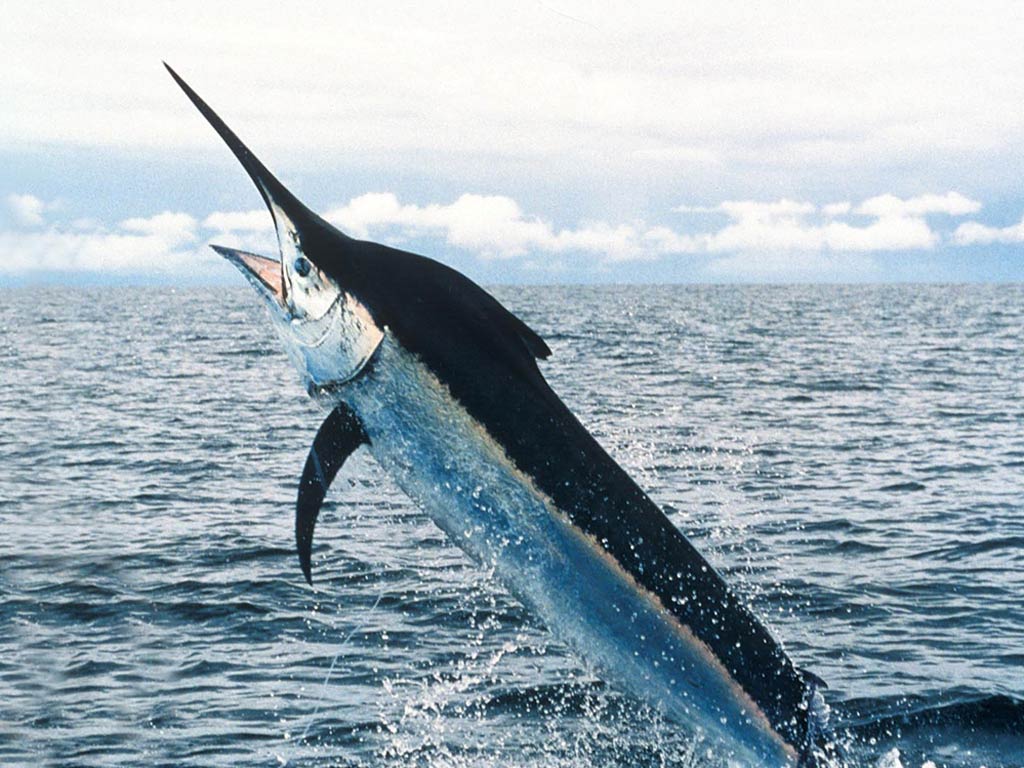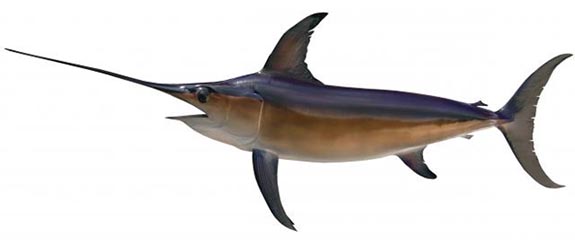
Xiphias gladius
FAMILY
Xiphiidae
TAXONOMY
Xiphias gladius Linnaeus, 1758, European seas.
OTHER COMMON NAMES
French: Espadon; Spanish: Pez espada.
PHYSICAL CHARACTERISTICS
Reaches a maximum size of 175 in (445 cm) total length and
approximately 1,190 lb (540 kg). The body is elongate and
cylindrical. Two widely separated dorsal fins in adults, the first
much larger than the second, the first with 34–49 rays, the second
with four to six rays. Two separate anal fins in adults, the
first with 12–16 rays, the second with three or four rays. Pectoral
fins falcate, located low on body sides, with 17–19 rays.
Caudal fin large and lunate, with a deep notch on upper and
lower profiles of caudal peduncle. Fine file-like teeth and scales
with small spines are present in juveniles but become embedded
in the skin with growth at approximately 3 ft (1 m) in
length. Left and right branchiostegal membranes separated distally.
Vertebrae, 26. Back and sides of body blackish brown,
gradually fading to light brown on ventral side.
DISTRIBUTION
Cosmopolitan in tropical, temperate, and sometimes cold waters
of all oceans, including the Mediterranean, Black, and
Caribbean seas.
HABITAT
This is an epipelagic and mesopelagic, oceanic species, usually
found in surface waters warmer than 55.4°F (13°C), the optimum
temperature range being 64.4–71.6°F (18–22°C). Swordfishes
have been acoustically tracked and directly observed
from submersibles in the western Atlantic and eastern Pacific
to depths of 2,024 ft (617 m).
BEHAVIOR
It is likely that swordfishes use the sword to stun or kill some
prey, as shown by slashes on the bodies of squid and fishes
found in swordfish stomachs. The brain and eyes of swordfish
are warmer than the water in which they live. The tissue that
heats the brain is developed from the superior rectus muscle of
the eye. The brain heater protects the central nervous system
from rapid cooling during vertical excursions of as much as
984 ft (300 m) that these fish may make through a temperature
range as great as 34.2°F (19°C) in 2 hours.
FEEDING ECOLOGY AND DIET
Adult swordfishes are opportunistic feeders, known to forage
for their food from the surface to the bottom over a wide
depth range. Over deep water, they feed primarily on pelagic
fishes including tuna, dolphinfishes, lancetfishes, flyingfishes,
and pelagic squids. In shallow waters swordfishes often take
neritic pelagic fishes such as mackerel, herring, anchovies, sardines,
and sauries. Large adults may make feeding trips to the
bottom for demersal fishes.
REPRODUCTIVE BIOLOGY
In the western Atlantic, spawning apparently occurs throughout
the year in the Caribbean, the Gulf of Mexico, and waters off
Florida. Swordfishes spawn in the upper water layers at depths
of 0–246 ft (0–75 m) and temperatures of approximately 73.4°F
(23°C). Swordfishes first spawn at 5 or 6 years of age and 59–67
in (150–170 cm) eye-fork length and lay 2–5 million eggs.
CONSERVATION STATUS
Listed by IUCN as Data Deficient. Populations of swordfish
have been greatly reduced by fishing, particularly in the Atlantic
Ocean. A consumer boycott of Atlantic swordfish organized by
the United States–based Natural Resources Defense Council and
Sea Web affected prices enough to gather crucial momentum
toward a recovery plan for depleted swordfish in the Atlantic
(Safina, 2001).
SIGNIFICANCE TO HUMANS
Appreciation of swordfish as a food fish is recent. Swordfishes
brought only approximately $0.24 per pound (0.5 kg) in 1919
and $0.60 in 1946. There are important fisheries for swordfish
in all three major oceans. Swordfishes are caught by long line,
harpoon, drift gill net, set nets, and other fishing gear. FAO
catch statistics for 1991–2000 show catches of 76–116 thousand
tons (69–105 thousand metric tons) per year by 77 countries.
Restrictions on the sale of swordfish containing levels of mercury
greater than 0.5 ppm in Canada and the United States in
the early 1970s caused collapse of the Canadian fishery and severely
restricted landings in the United States. The mercury
guidelines were raised to 1.0 ppm in 1979, and by 1980 catch
and effort had reached a new high in the northwest Atlantic.
Swordfishes are important sport fishes. The all-tackle game
fish record is a 1,182-lb (536.2-kg) fish taken off Chile.
Photo Gallery of - Swordfish





 Animalia Life
Animalia Life